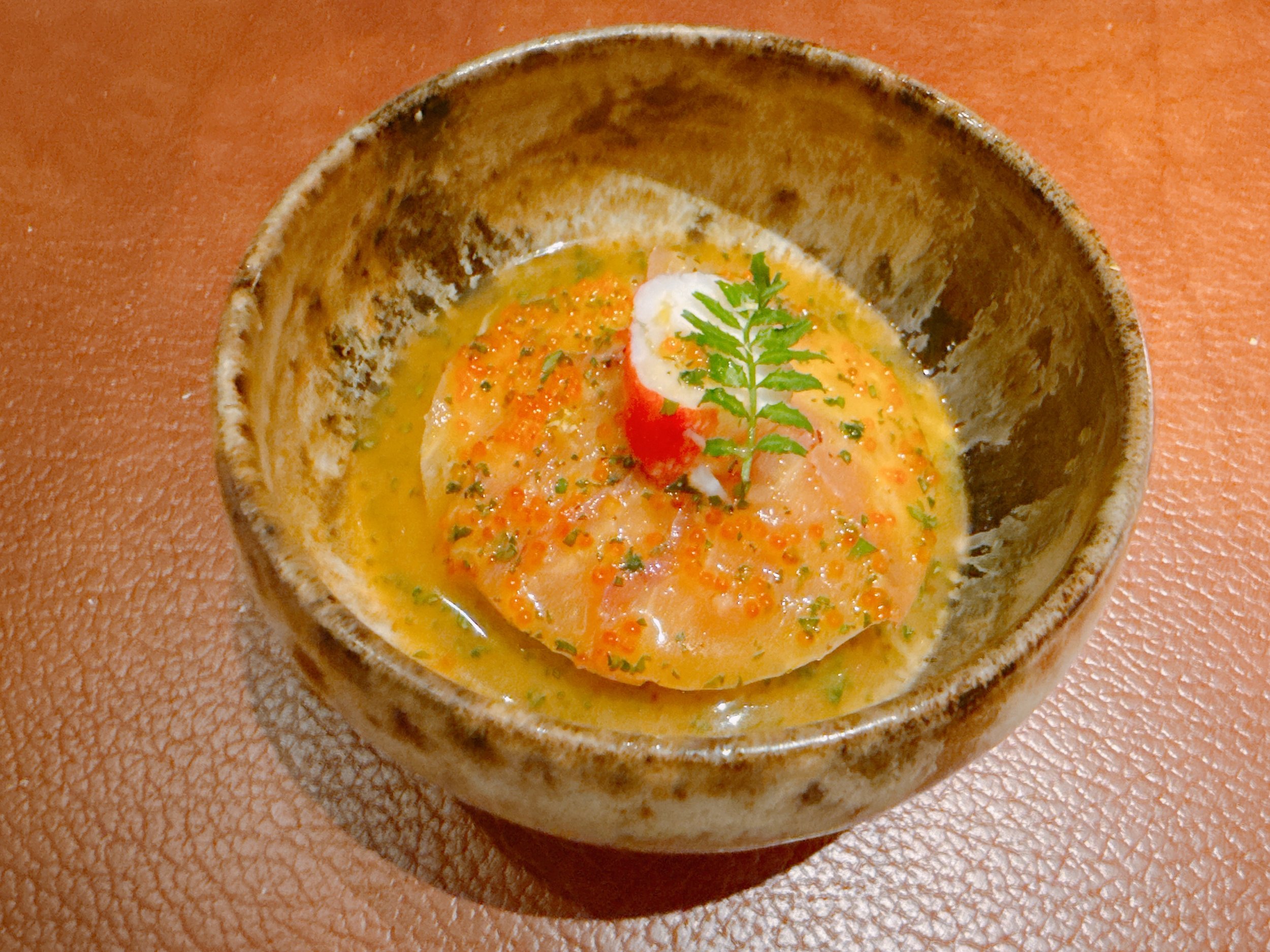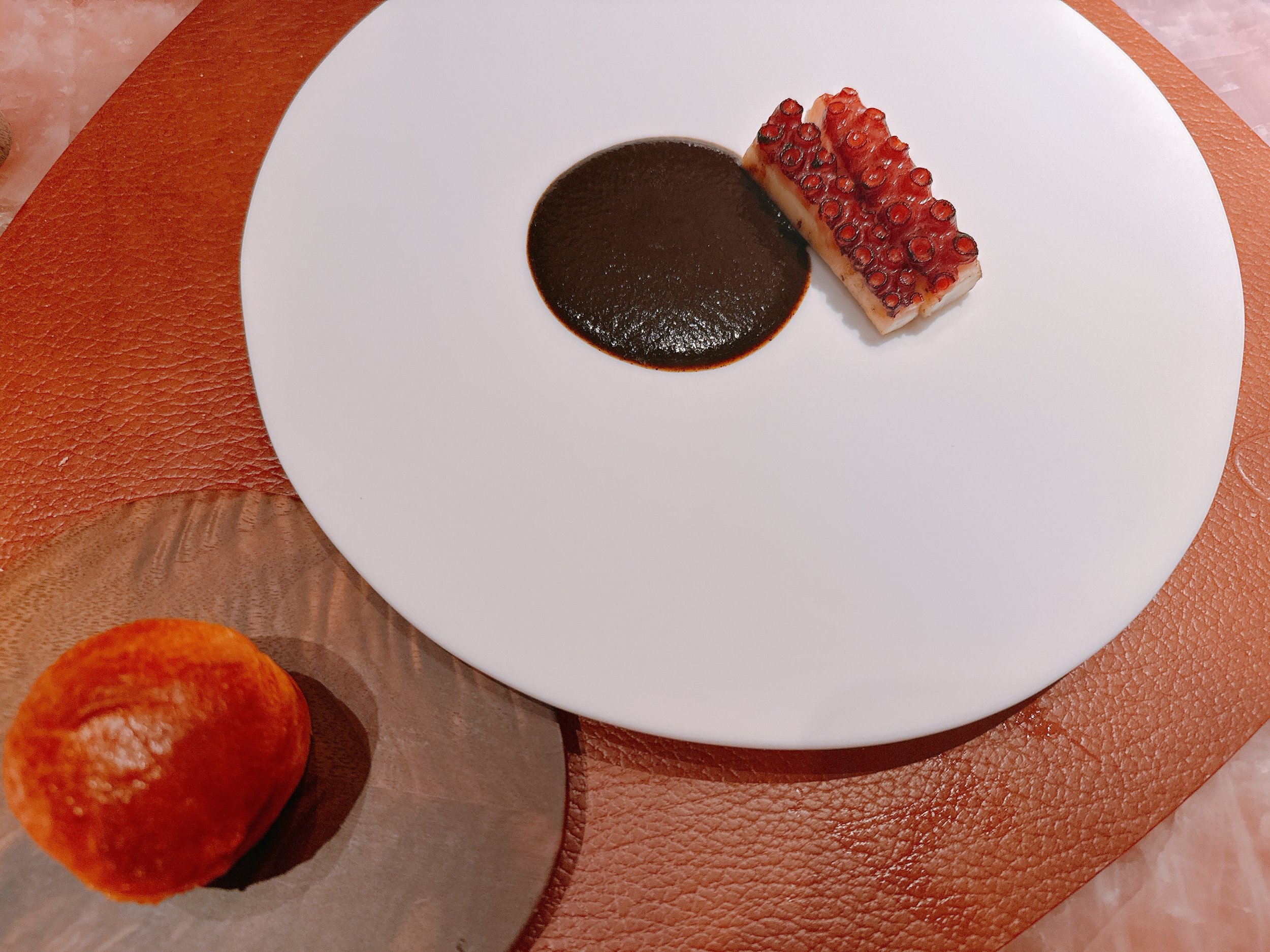Araya - Singapore
Rating: 16/20
Where: Singapore, Singapore
When: Dinner for 2 on 28 February 2025
Cost per Person: Tasting menu 168-368 SGD, Wine Pairing 90-280 SGD
Accolades: 1 Michelin Star
Why: Elevated Chilean cuisine with influences and ingredients from Japan
Going all the way to Singapore to eat Chilean food? At first glance, that might sound like an odd idea. But on the other hand, most of Singapore's Michelin-starred restaurants don't serve any local food. Singapore is a true culinary hub that attracts chefs from around the world and also has an open-minded audience that provides a market for their restaurants. So, trying to (mostly) avoid Western fare on a trip to Singapore, we found ourselves at “Araya”, a Chilean restaurant run by namesake chef Francisco Araya that opened in late 2023.
Araya is located on the ground floor of Singapore's Mondrian hotel, and one needs to ring a doorbell to enter. The interior design is all industrial chic, with lots of metal, but using warm, coppery colors. Almost all seats are at a counter that surrounds the kitchen. However, most of the kitchen is hidden behind a door, and chef Araya helms the outside portion at the counter.
There were no fewer than three tasting menus to choose from, a shorter introductory menu (168 SGD), a more meat-heavy eight-course menu (298 SGD) and a seafood-focused menu, also with eight courses (368 SGD). We went for the seafood menu, which still contained two meat dishes, but the restaurant was happy to replace them with pescatarian options for my wife. Note that the menu needs to be picked at reservation time, including any upgrades that one might like (we didn’t choose any). There were also three wine pairings, costing 90, 190 and 280 SGD, respectively. With increasing prices, they both became longer and featured fancier wines. Curiously, the pairings were the same for all tasting menus, even though the dishes were quite different. I went for the middle-priced option, since it consisted solely of wines from the Americas: from Argentina, Chile and the US, to be precise. The sommelier also poured us a couple of wines in addition to the pairing, including one from Spain. For the most part, the wines were good rather than amazing. However, they were also wines that one doesn't usually see in restaurants, for example the white wines from Argentina and Chile. For that reason alone, I had no regrets ordering the pairing.
The dinner started with three small bites. The first was a tomato meringue topped with amaebi (spot prawns) that were seasoned with merkén, a Chilean spice mix. This mix made the dish lightly spicy, while the amaebi had a creamy texture and the meringue was a bit sticky. A nice combination 17. A corn flan was topped with baby corn kernels seasoned with yuzu. The mini kernels had a nice crunch, but overall the flan's corn flavor was pretty light 17. “Chicha de uva” was a fermented grape juice - lightly acidic and lightly sweet 14.
Three kinds of bread were offered, all served very hot. A marraqueta was essentially a baguette roll, a chapalele was a potato roll, and a bocado de dama was an olive bread made with seaweed and a bit of beef fat. They came with two butters from Uruguay, seasoned with merkén and seaweed, respectively. All quite good, although the breads could have been a bit crunchier 16.
Official course number one was a kinmedai ceviche seasoned with yellow chilies, pickled black daikon and a lime dashi made with kaffir lime leaf oil. The fatty, creamy fish was very good, the daikon added some crunch and the lime-flavored sauce was lovely as well. The restaurant predominantly uses Japanese seafood, since the chef discovered that it is very similar to what he’d find in Chile 17.
Chilean king crab (centolla) was the basis of the next dish, served cold. The crab was topped with sliced oca, an Andean tuber, and the surrounding sauce had been made with grapefruit, garlic, fish roe, coriander and kinome leaf. The oca was crunchy and felt almost raw, the sauce was very aromatic and creamy with a hint of spice. In fact the sauce was so flavorful that it overpowered the more subtly flavored, tender crab 17.
Two seafood bites were served together. A spoon with a blue sphere was actually a dish featuring sardines with an escabeche made of vinegar, olive oil and aromatics. The sardines were excellent and intensely flavorful: a fresh, fishy, fatty fish 18. Next to it were some sliced clams (almejas), served with a salsa verde, yuzu kosho, lime zest, and coriander. The clams had a little bit of a bite, and the sauce was lightly spicy and acidic. Nice, but a big drop-off in flavor intensity from the sardines 16.
Foie gras was topped with smoked eel and surrounded by an Iberico pork dashi. The common texture among the eel and foie gras was one of creaminess, but the taste impression started with the very salty sauce before ending with the foie gras. The eel was less noticeable 16. The pescatarian replacement of this dish was a coral cracker, served with two kinds of seaweed, a huacatay espuma, borage and oyster leaves. A dish full of lovely herbal flavors, but maybe a bit too creamy 16.
Sawara (Spanish mackerel) was served with a beurre blanc containing chilies, fish roe, chives, shio kombu and citrus zest. The fish was only partially cooked and quite rich. The sauce was likewise rich and salty. While there was a bit of acidity to lighten up the dish, more might have been even better. The paired Oregon chardonnay was a great match for the buttery sauce 17.
The undisputed star of the next dish was a spiced sauce made from Ecuadorian chocolate and fifteen other ingredients, including almonds and cinnamon. It was a dark and pondering sauce, pretty heavy and spicy. In my case, the sauce was paired with a Bresse pigeon and a brioche filled with pigeon leg confit. The pigeon was cooked fine - I'm just not a big fan of the ingredient. The brioche was a bit sweet, and its filling wasn't too exciting 14. The pescatarian replacement was a Spanish octopus, nicely grilled but not too flavorful by itself. The brioche was supposedly flavored with pumpkin, but that was hard to make out. All in all, maybe a smidgen better than the pigeon 15.
The pre-dessert contained variations of Argentinian cherries: fresh, as a compote, and as a sorbet. The whole was topped with a meringue decorated with tiny drawings of cherries. On the side, we were served a cherry kombucha. The different flavors ranging from cooked to fresh were pretty nice, and the meringue was very sweet. The kombucha was just ok, though, it tasted a bit preserved 15.
Espuma of lucuma (a South American fruit) came with a rum ice cream and toasted pecans. The espuma and ice cream were served inside a sugar shell, which together with the nuts gave the dish a crunchy texture. The lucuma espuma was not fruity at all, it tasted more like butter scotch. And there was a bit too much of it for my taste, more ice cream might have been better 15.
Getting to the end of our dinner, we were offered a selection of petit fours, but unfortunately were only allowed to pick three each among a total of the fourteen options. We tried a dark chocolate with cherry, which started with a cherry flavor and ended on chocolate 14. A mango pate de fruit with aji pepper was fruity and quite spicy 16. A milk chocolate crunch with rum had only a minimal rum flavor 13. Dark chocolate with a praline filling was quite nice 16. White chocolate flavored with roasted corn had only a light corn taste 13, and a dark chocolate with cocoa nibs had a minimal crunch from the nibs 14.
Two digestifs were served at the end of dinner, one based on cherries, the other one on celery.
Overall: An enjoyable dinner of Chilean cuisine with Japanese ingredients. The service was friendly, and it was nice to have a chef who was very approachable. We also appreciated having something other than Western or local food on this trip, especially at such a high quality level 16.


















